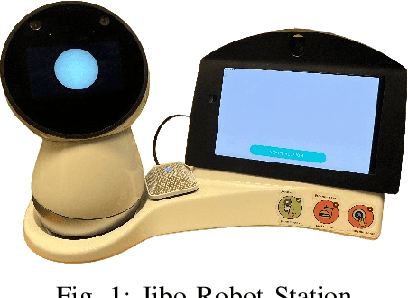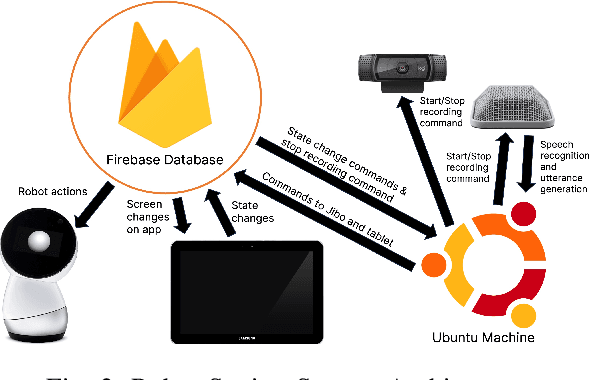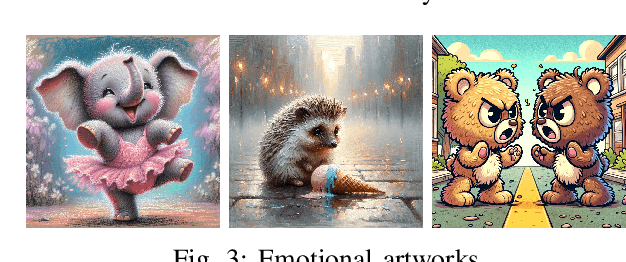Cynthia Breazeal
InvThink: Towards AI Safety via Inverse Reasoning
Oct 02, 2025Abstract:We present InvThink, a simple yet powerful approach that gives large language models (LLMs) the capability of inverse thinking: reasoning through failure modes before generating responses. Unlike existing safety alignment methods that optimize directly for safe response, InvThink instructs models to 1) enumerate potential harms, 2) analyze their consequences, and 3) generate safe outputs that proactively avoid these risks. Our method reveals three key findings: (i) safety improvements show stronger scaling with model size compared to existing safety methods. (ii) InvThink mitigates safety tax; by training models to systematically consider failure modes, it preserves general reasoning capabilities on standard benchmarks. (iii) beyond general safety tasks, InvThink excels in high-stakes domains including external-facing (medicine, finance, law) and agentic (blackmail, murder) risk scenarios, achieving up to 15.7% reduction in harmful responses compared to baseline methods like SafetyPrompt. We further implement InvThink via supervised fine-tuning, and reinforcement learning across three LLM families. These results suggest that inverse reasoning provides a scalable and generalizable path toward safer, more capable language models.
Tiered Agentic Oversight: A Hierarchical Multi-Agent System for AI Safety in Healthcare
Jun 14, 2025Abstract:Current large language models (LLMs), despite their power, can introduce safety risks in clinical settings due to limitations such as poor error detection and single point of failure. To address this, we propose Tiered Agentic Oversight (TAO), a hierarchical multi-agent framework that enhances AI safety through layered, automated supervision. Inspired by clinical hierarchies (e.g., nurse, physician, specialist), TAO conducts agent routing based on task complexity and agent roles. Leveraging automated inter- and intra-tier collaboration and role-playing, TAO creates a robust safety framework. Ablation studies reveal that TAO's superior performance is driven by its adaptive tiered architecture, which improves safety by over 3.2% compared to static single-tier configurations; the critical role of its lower tiers, particularly tier 1, whose removal most significantly impacts safety; and the strategic assignment of more advanced LLM to these initial tiers, which boosts performance by over 2% compared to less optimal allocations while achieving near-peak safety efficiently. These mechanisms enable TAO to outperform single-agent and multi-agent frameworks in 4 out of 5 healthcare safety benchmarks, showing up to an 8.2% improvement over the next-best methods in these evaluations. Finally, we validate TAO via an auxiliary clinician-in-the-loop study where integrating expert feedback improved TAO's accuracy in medical triage from 40% to 60%.
Words Like Knives: Backstory-Personalized Modeling and Detection of Violent Communication
May 27, 2025Abstract:Conversational breakdowns in close relationships are deeply shaped by personal histories and emotional context, yet most NLP research treats conflict detection as a general task, overlooking the relational dynamics that influence how messages are perceived. In this work, we leverage nonviolent communication (NVC) theory to evaluate LLMs in detecting conversational breakdowns and assessing how relationship backstory influences both human and model perception of conflicts. Given the sensitivity and scarcity of real-world datasets featuring conflict between familiar social partners with rich personal backstories, we contribute the PersonaConflicts Corpus, a dataset of N=5,772 naturalistic simulated dialogues spanning diverse conflict scenarios between friends, family members, and romantic partners. Through a controlled human study, we annotate a subset of dialogues and obtain fine-grained labels of communication breakdown types on individual turns, and assess the impact of backstory on human and model perception of conflict in conversation. We find that the polarity of relationship backstories significantly shifted human perception of communication breakdowns and impressions of the social partners, yet models struggle to meaningfully leverage those backstories in the detection task. Additionally, we find that models consistently overestimate how positively a message will make a listener feel. Our findings underscore the critical role of personalization to relationship contexts in enabling LLMs to serve as effective mediators in human communication for authentic connection.
BehaviorSFT: Behavioral Token Conditioning for Clinical Agents Across the Proactivity Spectrum
May 27, 2025Abstract:Large Language Models (LLMs) as clinical agents require careful behavioral adaptation. While adept at reactive tasks (e.g., diagnosis reasoning), LLMs often struggle with proactive engagement, like unprompted identification of critical missing information or risks. We introduce BehaviorBench, a comprehensive dataset to evaluate agent behaviors across a clinical assistance spectrum, ranging from reactive query responses to proactive interventions (e.g., clarifying ambiguities, flagging overlooked critical data). Our BehaviorBench experiments reveal LLMs' inconsistent proactivity. To address this, we propose BehaviorSFT, a novel training strategy using behavioral tokens to explicitly condition LLMs for dynamic behavioral selection along this spectrum. BehaviorSFT boosts performance, achieving up to 97.3% overall Macro F1 on BehaviorBench and improving proactive task scores (e.g., from 95.0% to 96.5% for Qwen2.5-7B-Ins). Crucially, blind clinician evaluations confirmed BehaviorSFT-trained agents exhibit more realistic clinical behavior, striking a superior balance between helpful proactivity (e.g., timely, relevant suggestions) and necessary restraint (e.g., avoiding over-intervention) versus standard fine-tuning or explicit instructed agents.
Aligning Dialogue Agents with Global Feedback via Large Language Model Reward Decomposition
May 21, 2025Abstract:We propose a large language model based reward decomposition framework for aligning dialogue agents using only a single session-level feedback signal. We leverage the reasoning capabilities of a frozen, pretrained large language model (LLM) to infer fine-grained local implicit rewards by decomposing global, session-level feedback. Our first text-only variant prompts the LLM to perform reward decomposition using only the dialogue transcript. The second multimodal variant incorporates additional behavioral cues, such as pitch, gaze, and facial affect, expressed as natural language descriptions. These inferred turn-level rewards are distilled into a lightweight reward model, which we utilize for RL-based fine-tuning for dialogue generation. We evaluate both text-only and multimodal variants against state-of-the-art reward decomposition methods and demonstrate notable improvements in human evaluations of conversation quality, suggesting that LLMs are strong reward decomposers that obviate the need for manual reward shaping and granular human feedback.
VocalAgent: Large Language Models for Vocal Health Diagnostics with Safety-Aware Evaluation
May 19, 2025Abstract:Vocal health plays a crucial role in peoples' lives, significantly impacting their communicative abilities and interactions. However, despite the global prevalence of voice disorders, many lack access to convenient diagnosis and treatment. This paper introduces VocalAgent, an audio large language model (LLM) to address these challenges through vocal health diagnosis. We leverage Qwen-Audio-Chat fine-tuned on three datasets collected in-situ from hospital patients, and present a multifaceted evaluation framework encompassing a safety assessment to mitigate diagnostic biases, cross-lingual performance analysis, and modality ablation studies. VocalAgent demonstrates superior accuracy on voice disorder classification compared to state-of-the-art baselines. Its LLM-based method offers a scalable solution for broader adoption of health diagnostics, while underscoring the importance of ethical and technical validation.
Does "Reasoning" with Large Language Models Improve Recognizing, Generating, and Reframing Unhelpful Thoughts?
Mar 31, 2025Abstract:Cognitive Reframing, a core element of Cognitive Behavioral Therapy (CBT), helps individuals reinterpret negative experiences by finding positive meaning. Recent advances in Large Language Models (LLMs) have demonstrated improved performance through reasoning-based strategies. This inspires a promising direction of leveraging the reasoning capabilities of LLMs to improve CBT and mental reframing by simulating the process of critical thinking, potentially enabling more effective recognition, generation, and reframing of cognitive distortions. In this work, we investigate the role of various reasoning methods, including pre-trained reasoning LLMs and augmented reasoning strategies such as CoT and self-consistency in enhancing LLMs' ability to perform cognitive reframing tasks. We find that augmented reasoning methods, even when applied to "outdated" LLMs like GPT-3.5, consistently outperform state-of-the-art pretrained reasoning models on recognizing, generating and reframing unhelpful thoughts.
A Demonstration of Adaptive Collaboration of Large Language Models for Medical Decision-Making
Oct 31, 2024



Abstract:Medical Decision-Making (MDM) is a multi-faceted process that requires clinicians to assess complex multi-modal patient data patient, often collaboratively. Large Language Models (LLMs) promise to streamline this process by synthesizing vast medical knowledge and multi-modal health data. However, single-agent are often ill-suited for nuanced medical contexts requiring adaptable, collaborative problem-solving. Our MDAgents addresses this need by dynamically assigning collaboration structures to LLMs based on task complexity, mimicking real-world clinical collaboration and decision-making. This framework improves diagnostic accuracy and supports adaptive responses in complex, real-world medical scenarios, making it a valuable tool for clinicians in various healthcare settings, and at the same time, being more efficient in terms of computing cost than static multi-agent decision making methods.
Can Language Models Take A Hint? Prompting for Controllable Contextualized Commonsense Inference
Oct 03, 2024


Abstract:Generating commonsense assertions within a given story context remains a difficult task for modern language models. Previous research has addressed this problem by aligning commonsense inferences with stories and training language generation models accordingly. One of the challenges is determining which topic or entity in the story should be the focus of an inferred assertion. Prior approaches lack the ability to control specific aspects of the generated assertions. In this work, we introduce "hinting," a data augmentation technique that enhances contextualized commonsense inference. "Hinting" employs a prefix prompting strategy using both hard and soft prompts to guide the inference process. To demonstrate its effectiveness, we apply "hinting" to two contextual commonsense inference datasets: ParaCOMET and GLUCOSE, evaluating its impact on both general and context-specific inference. Furthermore, we evaluate "hinting" by incorporating synonyms and antonyms into the hints. Our results show that "hinting" does not compromise the performance of contextual commonsense inference while offering improved controllability.
A HeARTfelt Robot: Social Robot-Driven Deep Emotional Art Reflection with Children
Sep 16, 2024



Abstract:Social-emotional learning (SEL) skills are essential for children to develop to provide a foundation for future relational and academic success. Using art as a medium for creation or as a topic to provoke conversation is a well-known method of SEL learning. Similarly, social robots have been used to teach SEL competencies like empathy, but the combination of art and social robotics has been minimally explored. In this paper, we present a novel child-robot interaction designed to foster empathy and promote SEL competencies via a conversation about art scaffolded by a social robot. Participants (N=11, age range: 7-11) conversed with a social robot about emotional and neutral art. Analysis of video and speech data demonstrated that this interaction design successfully engaged children in the practice of SEL skills, like emotion recognition and self-awareness, and greater rates of empathetic reasoning were observed when children engaged with the robot about emotional art. This study demonstrated that art-based reflection with a social robot, particularly on emotional art, can foster empathy in children, and interactions with a social robot help alleviate discomfort when sharing deep or vulnerable emotions.
 Add to Chrome
Add to Chrome Add to Firefox
Add to Firefox Add to Edge
Add to Edge